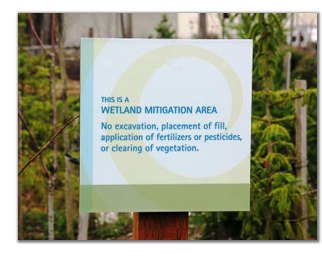Wetland mitigation compliance
We follow up on wetland mitigation sites to ensure mitigation requirements are fulfilled. Permittees are required to meet the terms and conditions of their permits, including successful implementation of any required mitigation plan. We find that compensatory mitigation projects that are reviewed for compliance by regulatory agencies are more successful (see the Wetland Mitigation Evaluation Study - Phase 2, Evaluating Success).
We work together with the U.S. Army Corps of Engineers (Corps), EPA, and local governments and take an active role in ensuring wetland mitigation compliance.
We strive to achieve voluntary compliance first
We work collaboratively with permittees to achieve voluntary compliance first. Non-compliance, however, may call for a compliance or enforcement action by the agencies that could result in additional compensatory mitigation requirements, judicial actions, or civil penalties.
Our staff also investigate reports of unpermitted activities in wetlands, streams, or other state waters, and initiate enforcement actions if alleged violations of law or regulation are found.
Agency responsibilities relative to mitigation compliance typically are to:
- Communicate and coordinate with permittees or their agents.
- Review status, project as-built, and monitoring reports.
- Inspect mitigation sites.
- Determine whether mitigation projects have met their performance standards and mitigation-specific permit conditions.
Examples of non-compliance related to compensatory mitigation include:
- Failure to implement the required mitigation plan.
- Failure to submit required as-built, status, and monitoring reports (see guidance).
- Failure to provide the required amount and type of required compensatory mitigation.
- Failure to meet the requirements of project-specific permit conditions.
Related links
Contact information
Wetland mitigation compliance staff:
- Dana Mock, dana.mock@ecy.wa.gov, 360-742-2826
- Patricia Johnson, patricia.johnson@ecy.wa.gov, 360-701-5558
- Kate Thompson, kate.thompson@ecy.wa.gov, 360-628-3445
- Devin Geiger, devin.geiger@ecy.wa.gov, 360-867-8164



